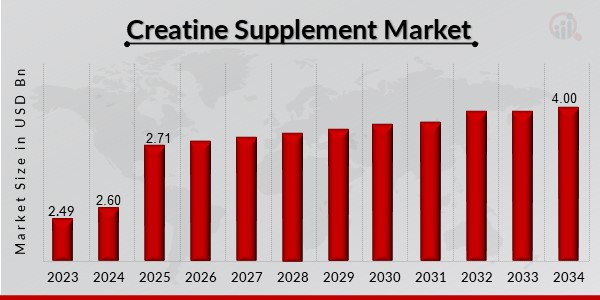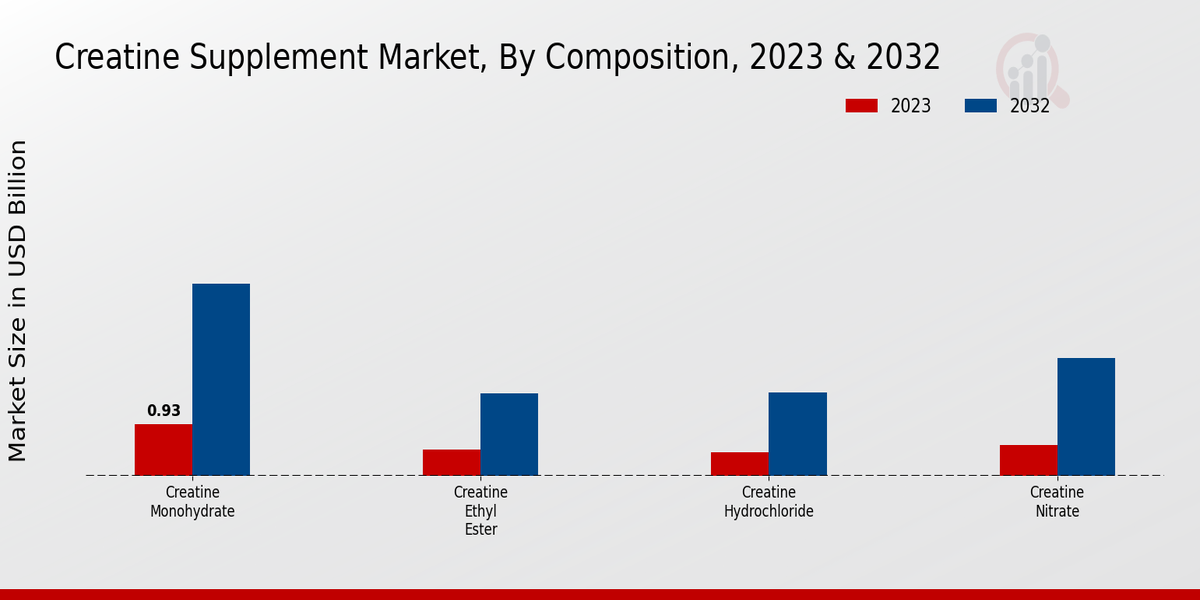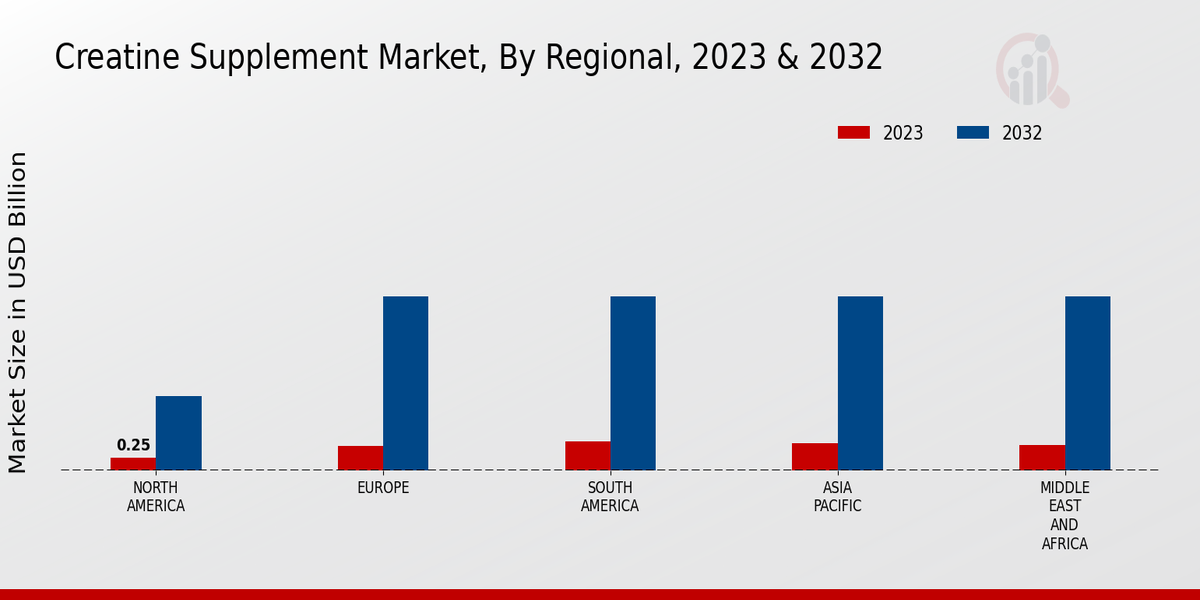Global Creatine Supplement Market Overview
Creatine Supplement Market Size was estimated at 2.60 (USD Billion) in 2024. The Creatine Supplement Industry is expected to grow from 2.71 (USD Billion) in 2025 to 4.00 (USD Billion) by 2034. The Creatine Supplement Market CAGR (growth rate) is expected to be around 4.4% during the forecast period (2025 - 2034).

Source Primary Research, Secondary Research, MRFR Database and Analyst Review
Key Creatine Supplement Market Trends Highlighted
The creatine supplement market continues to witness a surge in demand, driven by the growing popularity of fitness and bodybuilding. This demand is predominantly influenced by increased awareness of the performance-enhancing effects of creatine in athletic performance, muscle growth, and recovery. Furthermore, the growing adoption of plant-based diets and the subsequent need for vegan creatine supplements have further fueled market growth.
Key market drivers include the rising prevalence of obesity and associated health concerns, leading to an increased focus on weight management and fitness. Moreover, the growing acceptance of creatine supplementation among professional athletes and fitness enthusiasts has significantly contributed to its mainstream adoption. Emerging markets, particularly in the Asia-Pacific region, are also presenting substantial growth opportunities due to the increasing disposable income and the growing middle class, who are becoming more health-conscious.
Recent trends in the creatine supplement market include the rise of micro-dosing, where individuals consume smaller doses of creatine throughout the day for sustained energy levels. Additionally, the development of novel creatine formulations, such as creatine ethyl ester and creatine hydrochloride, has catered to specific consumer needs and preferences. The market is also witnessing the integration of creatine with other supplements, such as protein powders and pre-workout formulas, to enhance effectiveness and convenience.
Creatine Supplement Market Drivers
Rising Prevalence of Fitness-Conscious Consumers
The main factor that drives the demand for creatine supplements in the market of sports nutrition is the increasing awareness of the benefits of such products. At present, it is well known that creatine supplementation can enhance muscle strength and power, as well as muscle performance in general and facilitate recovery. As more and more people become physically active and engage in sports and other fitness activities, there is an increased need for supplements that can help people meet their goals.In addition, the growing field of sports nutrition and the increasing number of fitness influencers also contribute to the market growth.
Technological Advancements and Product Innovation
Constant improvements in manufacturing technologies and product formulations are typical to today’s Creatine Supplement Market Industry. Manufacturers tend to develop new products to meet the changing consumption trends. Creatine supplements are currently available in various forms, including capsules, powders, and gummies, which increased their accessibility. Additionally, new creatine delivery systems, such as liposomal creatine, appeared on the market, which are said to improve the bioavailability and effectiveness of the supplements.
Expansion of E-commerce and Online Sales
E-commerce platforms are thriving and their rapid development creates a large amount of opportunities to distribute and sell creatine supplements. The existing marketplaces allow customers to access a spectrum of different creatine products. More and more people prefer buying creatine on the web because it is cheap, convenient, and it is delivered to the doors of their homes in a short time.
Creatine Supplement Market Segment Insights
Creatine Supplement Market Composition Insights
The creatine supplement market is divided by composition into creatine monohydrate, creatine ethyl ester, creatine hydrochloride, creatine nitrate, and other creatine derivatives. Creatine monohydrate is the most popular and prescribed type of creatine, regarded to compose more than 90% of the market share. It is a stable and well-directed manner of creatine with a significant amount of scientific literature supporting its capability to enhance muscle strength, power, and endurance. Creatine ethyl ester is perhaps a less popular and more expensive type as the manufacturers claim it to be a more absorbable form of creatine.However, there is no scientific literature to support these claims. Creatine hydrochloride is the third popular type with absorbable claims, meaning its greater solubility may be suitable for people who have difficulty absorbing creatine monohydrate. Creatine nitrate is a novel type of creatine with a few claims, the main being improved blood flow, reduced muscle fatigue, and accelerated growth of muscle mass. However, there is an insignificant amount of scientific literature affirming these claims. Other creatine derivatives include creatine malate, creatine phosphate, and creatine citrate.They are less popular than creatine monohydrate, although they offer a few substantial advantages. Creatine malate reportedly reduces muscle soreness, and creatine phosphate enhances muscle recovery. The popularization of creatine supplements among amateur and professional athletes as the prestige of fitness-performance supplements is increasing is considered to be the main reason for this skyrocketing growth.

Source Primary Research, Secondary Research, MRFR Database and Analyst Review
Creatine Supplement Market Form Insights
The form segment of the Creatine Supplement Market is classified into powder, capsule, tablet, and liquid. The powder segment accounted for the largest market share, and it is projected to dominate the market not only in 2023 but also during the forecast period. It is a common form of taking other dietary supplements and a preferable choice because of the benefits in terms of convenience and price for consumers. The capsule segment is projected to have similar growth, as it also offers the convenience of taking and does not require additional equipment.The tablet and liquid form segments, which will also increase, will, however, do it at a comparatively slower rate. These form segments also target relatively narrow markets of targeted consumers. Overall, the Creatine Supplement Market is projected to grow at a rate of 4.4 percent from the 2023 to 2032 period, reaching the market size of USD 3.5 billion by 2032.
Creatine Supplement Market Application Insights
The Creatine Supplement Market is segmented based on application into Muscle Building, Endurance Enhancement, Recovery Acceleration, Cognitive Function Improvement, and Other Applications. Among these, the Muscle Building segment held the largest market share in 2023 and is projected to maintain its dominance throughout the forecast period. The rising popularity of bodybuilding and fitness activities, coupled with the increasing awareness of the benefits of creatine for muscle growth and strength, is driving the growth of this segment. The endurance Enhancement segment is expected to witness the fastest growth rate during the forecast period, owing to the increasing participation in endurance sports and the growing demand for supplements that can enhance performance and recovery time.The recovery Acceleration segment is also anticipated to exhibit significant growth, as creatine has been shown to accelerate muscle recovery after intense exercise. The Cognitive Function Improvement segment is expected to grow steadily over the forecast period owing to growing research on the potential benefits of creatine for cognitive function. The other Applications segment includes applications such as weight loss, diabetes management, and neurological disorders and is expected to contribute a small but growing share of the overall market.
Creatine Supplement Market Target Group Insights
The Creatine Supplement Market segmentation by Target Group includes Athletes, Bodybuilders, Fitness Enthusiasts, Elderly Population, and Other Target Groups. Athletes and bodybuilders represent a significant portion of the market, driven by their need to enhance performance and muscle recovery. Fitness enthusiasts are increasingly using creatine supplements to improve their workout intensity and endurance. The elderly population is also showing interest in creatine supplementation for its potential benefits in preserving muscle mass and strength.Other target groups, such as individuals with certain medical conditions or specific dietary needs, may also contribute to market growth.
Creatine Supplement Market Sales Channel Insights
The Creatine Supplement Market is segmented into various sales channels, including Online Stores, Brick-and-Mortar Stores, Health Food Stores, Fitness Centers, and Other Sales Channels. Each channel plays a crucial role in distributing creatine supplements to consumers, with varying market shares and growth potential. Online Stores have emerged as a significant sales channel for creatine supplements, driven by the convenience and wide selection they offer. The increasing penetration of e-commerce and the rise of online marketplaces have contributed to the growth of this channel.
Brick-and-mortar stores, such as supermarkets, drugstores, and specialty sports nutrition stores, continue to hold a substantial share of the market, providing consumers with the advantage of in-person shopping and expert advice. Health Food Stores cater to health-conscious consumers seeking natural and organic supplements, including creatine. Fitness Centers often serve as a distribution point for creatine supplements, targeting fitness enthusiasts and professionals. Other Sales Channels, such as direct sales through manufacturers' websites and distributors, also contribute to the market's growth.The Creatine Supplement Market is expected to witness steady growth in the coming years, driven by rising health consciousness, increased participation in fitness activities, and the growing popularity of creatine as an effective muscle-building supplement.
Creatine Supplement Market Regional Insights
The Creatine Supplement Market is segmented into North America, Europe, Asia-Pacific, South America, and the Middle East and Africa. North America held the largest market share in 2023 and is expected to continue to dominate the market throughout the forecast period. The market growth in this region is attributed to the increasing popularity of fitness and bodybuilding, as well as the rising awareness of the benefits of creatine supplementation. Europe is the second-largest market for creatine supplements and is expected to experience steady growth over the forecast period.The market in this region is driven by the increasing demand for sports nutrition products, as well as the growing popularity of creatine among athletes. The Asia-Pacific region is expected to be the fastest-growing market for creatine supplements over the forecast period. The market growth in this region is attributed to the rising disposable incomes, as well as the increasing awareness of the benefits of creatine supplementation. South America, the Middle East, and Africa are expected to experience moderate growth over the forecast period.
The market growth in these regions is attributed to the increasing popularity of fitness and bodybuilding, as well as the growing awareness of the benefits of creatine supplementation.

Source Primary Research, Secondary Research, MRFR Database and Analyst Review
Creatine Supplement Market Key Players And Competitive Insights
Creatine Supplement Market’s major players in the creatine supplement industry are continuously investing in research and development to introduce innovative products, expand their product portfolio and gain a leading position in the market. Moreover, leading players in Creatine Supplement Market are focusing on strategic partnerships, mergers, and acquisitions to enhance their market business across the globe. Increasing consumer interest in purchasing creatine supplements in order to gain the benefits of muscle growth, strength, and endurance is driving the creatine supplement market. The notable thing about Creatine Supplement Market is that it is full of established as well as small regional creatine supplement purple players market. Glanbia is the most notable player in the Creatine Supplement Market. Glanbia offers a wide range of creatine supplements, which include creatine monohydrate, creatine ethyl ester, and creatine hydrochloride, among others. However, the company offers effective and quality products that meet all industrial standards. Moreover, Glanbia is equipped with a great distribution network across the region. Furthermore, the company is also focused on its investment in research and development in order to develop innovative products and update the formulations of existing products.
The second major competitor in Creatine Supplement Market is Optimum Nutrition. The company’s reputation is based on innovative products and high credibility in sports nutrition. Additionally, Optimum Nutrition offers a wide range of creatine supplements, such as micronized creatine, creatine anhydrous, and creatine blends. Furthermore, it is one of the most trusted brands among sports professionals and athletes across the globe. Most significantly, Optimum Nutrition’s major objective is to produce products based on the principles of this market backed by scientific research and produced to support an athlete’s performance and recovery. Also, products are provided with inspiring customer service.
Key Companies in the Creatine Supplement Market Include
- MuscleTech
- Cellucor
- Irwin Naturals
- Myprotein
- Dymatize
- Optimum Nutrition
- BPI Sports
- Swanson Vitamins
- NOW Foods
- BulkSupplements
- Universal Nutrition
- Sheer Strength Labs
- Kaged Muscle
- GNC
- BSN
Creatine Supplement Market Industry Developments
The creatine supplement market is projected to reach USD 3.5 billion by 2032, exhibiting a CAGR of 4.4% during the forecast period (2024-2032). Rising consumer awareness about fitness and bodybuilding, increasing prevalence of chronic diseases, and growing popularity of vegan and vegetarian diets are key factors driving market growth. Technological advancements, such as the development of new creatine formulations with enhanced absorption and efficacy, are further fueling market expansion. Key industry participants are focusing on strategic partnerships, acquisitions, and product launches to gain a competitive edge. Recent developments include the acquisition of Nutrabolt by Glanbia and the launch of new creatine products by Optimum Nutrition and MuscleTech.
Creatine Supplement Market Segmentation Insights
- Creatine Supplement Market Composition Outlook
- Creatine Monohydrate
- Creatine Ethyl Ester
- Creatine Hydrochloride
- Creatine Nitrate
- Other Creatine Derivatives
- Creatine Supplement Market Form Outlook
- Powder
- Capsule
- Tablet
- Liquid
- Creatine Supplement Market Application Outlook
- Muscle Building
- Endurance Enhancement
- Recovery Acceleration
- Cognitive Function Improvement
- Other Applications
- Creatine Supplement Market Target Group Outlook
- Athletes
- Bodybuilders
- Fitness Enthusiasts
- Elderly Population
- Other Target Groups
- Creatine Supplement Market Sales Channel Outlook
- Online Stores
- Brick-and-Mortar Stores
- Health Food Stores
- Fitness Centers
- Other Sales Channels
- Creatine Supplement Market Regional Outlook
- North America
- Europe
- South America
- Asia Pacific
- Middle East and Africa
| Report Attribute/Metric |
Details |
| Market Size 2024 |
2.60 (USD Billion) |
| Market Size 2025 |
2.71 (USD Billion) |
| Market Size 2034 |
4.00 (USD Billion) |
| Compound Annual Growth Rate (CAGR) |
4.4% (2025 - 2034) |
| Report Coverage |
Revenue Forecast, Competitive Landscape, Growth Factors, and Trends |
| Base Year |
2024 |
| Market Forecast Period |
2025 - 2034 |
| Historical Data |
2019 - 2023 |
| Market Forecast Units |
USD Billion |
| Key Companies Profiled |
MuscleTech, Cellucor, Irwin Naturals, Myprotein, Dymatize, Optimum Nutrition, BPI Sports, Swanson Vitamins, NOW Foods, BulkSupplements, Universal Nutrition, Sheer Strength Labs, Kaged Muscle, GNC, BSN |
| Segments Covered |
Composition, Form, Application, Target Group, Sales Channel, Regional |
| Key Market Opportunities |
1 Growing demand in sports nutrition2 Rising popularity among fitness enthusiasts3 Increasing awareness of health benefits4 Expansion in emerging markets5 Launch of innovative products |
| Key Market Dynamics |
Rising demand for sports nutrition products Increasing awareness of creatine benefits Growing popularity of gyms and fitness centers Product innovation and new product launches Growing ecommerce segment |
| Countries Covered |
North America, Europe, APAC, South America, MEA |
Frequently Asked Questions (FAQ) :
The creatine supplement market was valued at USD 2.71 billion in 2025 and is expected to reach USD 4.00 billion by 2034, exhibiting a CAGR of 4.4% during the forecast period.
North America is expected to hold the largest market share in the creatine supplement market throughout the forecast period. The region's large and well-established fitness industry, along with a growing awareness of the benefits of creatine supplementation, is driving market growth.
The sports nutrition segment is expected to witness the highest growth rate in the creatine supplement market during the forecast period. The increasing number of fitness enthusiasts and athletes seeking to enhance their performance is fueling the demand for creatine supplements.
Some of the key competitors in the creatine supplement market include Glanbia Plc, NOW Foods, Optimum Nutrition, MuscleTech, and Dymatize Nutrition.
The increasing popularity of fitness and bodybuilding activities, rising awareness of the benefits of creatine supplementation, and growing disposable income in developing countries are some of the key factors driving the growth of the creatine supplement market.
The creatine supplement market faces several challenges, including stringent regulatory requirements, concerns over potential side effects, and intense competition from other sports nutrition supplements.
The growing popularity of plant-based creatine supplements, the expansion of e-commerce channels, and the increasing demand for personalized nutrition solutions present opportunities for growth in the creatine supplement market.
Some key trends in the creatine supplement market include the increasing adoption of creatine monohydrate, the growing popularity of creatine ethyl ester, and the emergence of innovative delivery formats such as creatine gummies.
The COVID-19 pandemic had a mixed impact on the creatine supplement market. While gym closures and disruptions in the supply chain initially impacted sales, the growing focus on home workouts and personal health led to increased demand for creatine supplements in the long run.
The creatine supplement market is expected to continue growing steadily in the coming years. The increasing popularity of fitness and bodybuilding activities, rising disposable income, and growing awareness of the benefits of creatine supplementation are expected to drive market growth.

















